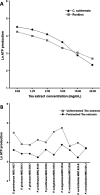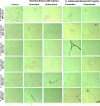Biocontrol of Fusarium Species Utilizing Indigenous Rooibos and Honeybush Extracts
- PMID: 37222581
- PMCID: PMC10269529
- DOI: 10.1128/spectrum.02742-22
Biocontrol of Fusarium Species Utilizing Indigenous Rooibos and Honeybush Extracts
Abstract
Mycotoxins produced by several Fusarium species have a significant effect on reducing maize yield and grain quality and have led to food safety concerns. The antifungal activities of rooibos (Aspalathus linearis) and honeybush (Cyclopia species) tea extracts reduced the growth of plant pathogen Botrytis cinerea, but their efficacy against Fusarium spp. is unknown. In this study, we examined the effects of fermented and unfermented rooibos (A. linearis) and honeybush (Cyclopia subternata) aqueous extracts as well as green tea (Camellia sinensis) against 10 Fusarium species. Conidial viability was assessed by fluorescence microscopy dyes, ATP production was determined using the BacTiter-Glo assay, the mode of action was analyzed by scanning electron microscopy (SEM), and quantification of polyphenols was done using high-performance liquid chromatography with diode array detection (HPLC-DAD). Fermented rooibos extract demonstrated the highest antifungal activity (P < 0.0001) against Fusarium verticillioides MRC 826-E, Fusarium subglutinans MRC 8553, Fusarium proliferatum MRC 8549, and Fusarium globosum MRC 6647, with only 9.53%, 9.26%, 11.0%, and 12.7% ATP production, respectively, followed by antifungal activity of the fermented C. subternata extract against F. subglutinans MRC 8553, F. subglutinans MRC 8554, F. proliferatum MRC 8550, and F. verticillioides MRC 826-E with 3.79%, 6.04%, 6.04%, and 8.40% ATP production, respectively. Extract-treated conidia examined by SEM exhibited disruption of conidial hyphae and collapsed spores. Overall, the fermented rooibos and C. subternata extracts showed higher antifungal activity against the Fusarium species than the unfermented extracts. IMPORTANCE In maize subsistence farming areas in South Africa, daily consumption of maize contaminated by high level of mycotoxins contributes to long-term health effects such as immune deficiency and cancer. Biocontrol methods that are safe and cost-effective are critical to addressing this public health problem. Plant extracts known as biocides or green pesticides are alternatives to chemical pesticides due to their safety and eco-friendly properties. In South Africa, rooibos (Aspalathus linearis) and honeybush (Cyclopia species) contain polyphenols with significant antioxidant and antimicrobial properties. These indigenous herbal teas are widely available and consumed in South Africa and have potential as an innovative approach to reduce mycotoxin levels and, subsequently, human and animal exposure to these toxins. This study evaluates the efficacy of the antifungal activities of several aqueous extracts prepared from fermented and unfermented rooibos (A. linearis), honeybush (Cyclopia subternata), and green tea (Camellia sinensis) on 10 Fusarium strains.
Keywords: Fusarium species; antifungal activity; honeybush; rooibos.
Conflict of interest statement
The authors declare no conflict of interest.
Figures





Similar articles
-
A comparative study on the antimutagenic properties of aqueous extracts of Aspalathus linearis (rooibos), different Cyclopia spp. (honeybush) and Camellia sinensis teas.Mutat Res. 2006 Dec 10;611(1-2):42-53. doi: 10.1016/j.mrgentox.2006.06.030. Epub 2006 Sep 1. Mutat Res. 2006. PMID: 16949333
-
Evaluation of capillary electrophoresis for the analysis of rooibos and honeybush tea phenolics.Electrophoresis. 2017 Mar;38(6):897-905. doi: 10.1002/elps.201600349. Epub 2016 Dec 27. Electrophoresis. 2017. PMID: 27921291
-
The potential role of polyphenols in the modulation of skin cell viability by Aspalathus linearis and Cyclopia spp. herbal tea extracts in vitro.J Pharm Pharmacol. 2016 Nov;68(11):1440-1453. doi: 10.1111/jphp.12629. Epub 2016 Sep 27. J Pharm Pharmacol. 2016. PMID: 27671741
-
A review of the bioactivity of South African herbal teas: rooibos (Aspalathus linearis) and honeybush (Cyclopia intermedia).Phytother Res. 2007 Jan;21(1):1-16. doi: 10.1002/ptr.1992. Phytother Res. 2007. PMID: 16927447 Review.
-
South African herbal teas: Aspalathus linearis, Cyclopia spp. and Athrixia phylicoides--a review.J Ethnopharmacol. 2008 Oct 28;119(3):376-412. doi: 10.1016/j.jep.2008.06.014. Epub 2008 Jun 22. J Ethnopharmacol. 2008. PMID: 18621121 Review.
Cited by
-
Valorisation of raw mango pickle industry waste into antimicrobial agent against postharvest fungal pathogens.Curr Res Microb Sci. 2024 May 26;6:100243. doi: 10.1016/j.crmicr.2024.100243. eCollection 2024. Curr Res Microb Sci. 2024. PMID: 38873591 Free PMC article.
References
-
- Avila CF, Moreira GM, Nicolli CP, Gomes LB, Abreu LM, Pfenning LH, Haidukowski M, Moretti A, Logrieco A, Del-Ponte EM. 2019. Fusarium incarnatum-equiseti species complex associated with Brazilian rice: phylogeny, morphology and toxigenic potential. Int J Food Microbiol 306:108267. doi:10.1016/j.ijfoodmicro.2019.108267. - DOI - PubMed
-
- Hassan ZU, Al Thani R, Balmas V, Migheli Q, Jaoua S. 2019. Prevalence of Fusarium fungi and their toxins in marketed feed. Food Control 104:224–230. doi:10.1016/j.foodcont.2019.04.045. - DOI
-
- Wang BB, Guo C, Sun SL, Xia YS, Zhu ZD, Duan CX. 2020. The genetic diversity, pathogenicity, and toxigenic chemotypes of Fusarium graminearum species complex causing maize ear rot. J Sci Agric Sin 53:4777–4790. doi:10.3864/j.issn.0578-1752.2020.23.005. - DOI
-
- Jimenez-Garcia SN, Garcia-Mier L, Garcia-Trejo JF, Ramirez-Gomez XS, Guevara-Gonzalez RG, Feregrino-Perez AA. 2018. Fusarium mycotoxins and metabolites that modulate their production. In Askun T (ed), Fusarium: plant diseases, pathogen diversity, genetic diversity, resistance and molecular markers. InTech, London, United Kingdom.
Publication types
MeSH terms
Substances
Supplementary concepts
LinkOut - more resources
Full Text Sources
Molecular Biology Databases
Miscellaneous

